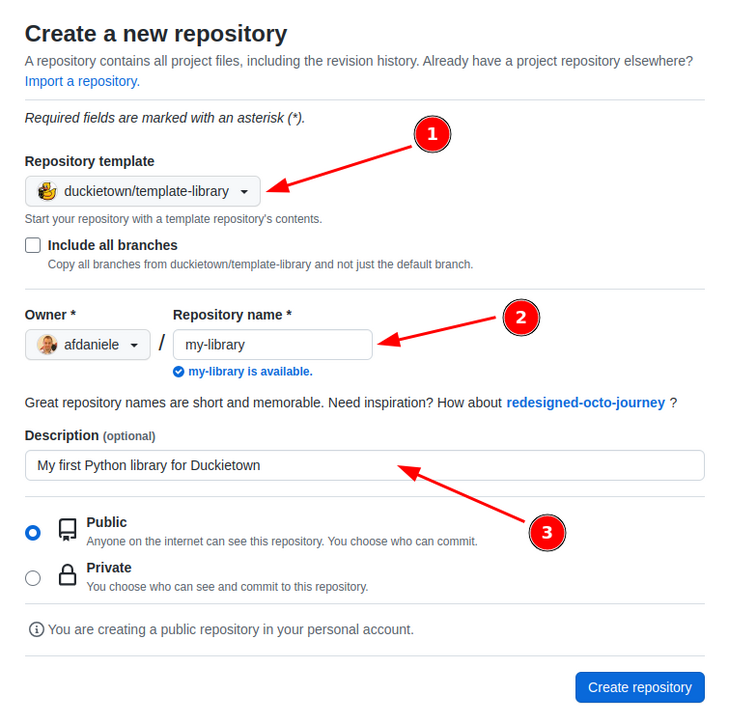Beginner - Python Library
Contents
Beginner - Python Library#
In this section, you will create your own Python library following the Duckietown template.
Step 1: Get the Duckietown library template#
A boilerplate is provided by the library template repository.
The repository contains a lot of files, but do not worry, we will analyze them one by one. Click on the button that reads “Use this template” and then choose “Create a new repository” from the dropdown menu.

Fig. 11 Use template repository on GitHub.#
This will take you to a page that looks like the following:

Fig. 12 Creating a repository from template.#
Pick a name for your repository (say my-library) and press the button Create repository from template.
Note
You can replace my-library with the name of the repository that you prefer.
This will create a new repository and copy everything from the repository template-library to your new repository. You can now open a terminal and clone your newly created repository.
git clone https://github.com/YOUR_USERNAME/my-library
cd my-library
Attention
Replace YOUR_USERNAME in the link above with your GitHub username.
Features of the library template#
We have the following features in our new library:
Unit-tests using Nose.
Building/testing in Docker environment locally.
Integration with CircleCI for automated testing.
Integration with CodeCov for displaying coverage result.
Integration with Sphinx to build code docs. (So far, only built locally.)
Jupyter notebooks, which are run also in CircleCI as tests.
Version bump using Bumpversion.
Code formatting using Black.
Command-line program for using the library.
Anatomy of the library template#
This repository describes a library called “duckietown_pondcleaner” and there is one command-line tool called dt-pc-demo.
Meta-files#
.gitignore: Files ignore by Git..dtproject: Enables the project to be built and used bydts develtools.bumpversion.cfg: Configuration for bumpversionMakefile: Build tools configuration with Make
Python packaging#
requirements.txt: Contains the pinned versions of your requirement that are used to run tests.MANIFEST.in: Deselects the tests to be included in the egg.setup.py: Contains meta information, definition of the scripts, and the dependencies information.
Python code#
src/- This is the path that you should set as “sources root” in your toolsrc/duckietown_pondcleaner: Contains the code.src/duckietown_pondcleaner/__init__.py: Contains the__version__library.src/duckietown_pondcleaner_tests: Contains the tests - not included in the egg.
Docker testing#
These are files to build and run a testing container.
.dockerignore: Describes what files go in the docker container.Dockerfile: The build configuration for the software image
Sphinx#
src/conf.py: Sphinx settingssrc/index.rst: Sphinx main filesrc/duckietown_pondcleaner/index.rst: Documentation for the package
Coverage#
.coveragerc: Options for code coverage.
Notebooks#
notebooks: Notebooks that are run also as a test.notebooks-extra: Other notebooks (not run as test)notebooks/*.ipynb: The notebooks themselves.
Step 2: Creating your Library#
Using the repo you have already created:
Clone the newly created repository;
Place your Python packages inside
src/;List the python dependencies in the file
dependencies.txt;Update the appropriate section in the file
setup.py;
Make sure that there are no other remains:
grep -r . pondcleaner
Update the branch names in README.md.
Other set up (for admins)#
The following are necessary steps for admins to do:
Activate on CircleCI. Make one build successful.
Activate on CodeCov. Get the
CODECOV_TOKEN. Put this token in CircleCI environment.
Step 3: Using the library template utilities#
Test the code#
Test the code using Docker by:
make test-docker
This runs the test using a Docker container built from scratch
with the pinned dependencies in requirements.txt.
This is equivalent to what is run on CircleCI.
To run the tests natively on your pc, use:
make test
Note
To run the tests you will need to have installed the libraries listed in the file requirements.txt on your computer.
For that we assume you have already set up a Python virtual environment.
To use a Python virtual environment you will need to pip install virtualenv then virtualenv duckietown then source duckietown/bin/activate. In order to install the requirements to run the test do pip install -r requirements.txt.
Development#
In the same virtual environment as above run:
python setup.py develop
This will install the library in an editable way (rather than copying the sources somewhere else).
If you don’t want to install the deps, do:
python setup.py develop --no-deps
For example, this is done in the Dockerfile so that
we know we are only using the dependencies in requirements.txt with the
exact pinned version.
Adding tests#
To add another tests, add files with the name test_*py in the
package duckietown_podcleaner_tests. The name is important.
Tip
Make sure that the tests are actually run by looking at the coverage results.
Using the notebooks#
Always clean the notebooks before committing them:
make -C notebooks cleanup
Warning
If you don’t think you can be diligent about this, then add the notebooks using Git LFS.
Step 4: Releasing a new version of your library#
Updating the version#
The first step is to change the version and tag the repo.
DO NOT change the version manually; use the CLI tool bumpversion instead.
The tool can be called by:
make bump # bump the version, tag the tree
If you need to include the version in a new file, list it inside the file .bumpversion.cfg using the
syntax [bumpversion:file: <FILE_PATH >].
Releasing the package#
The next step is to upload the package to PyPy. We use twine. Invoke it using:
make upload # upload to PyPI
For this step, you need to have admin permissions on PyPy.
